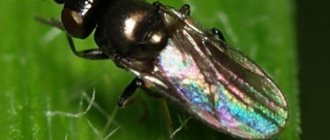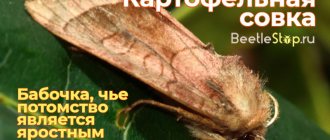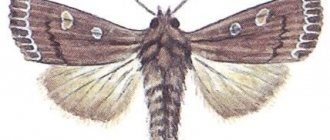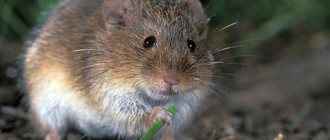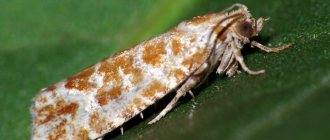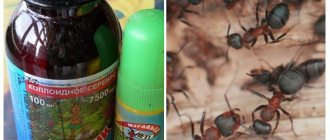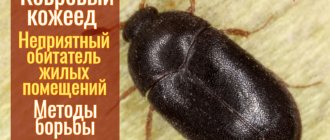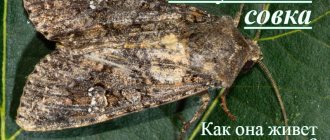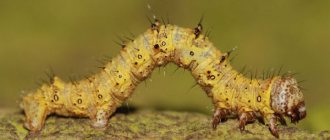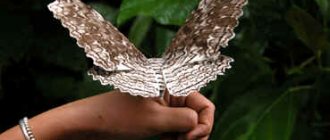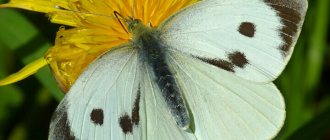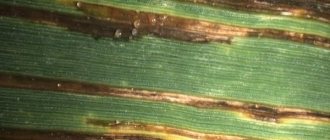Home Diseases and pests
The cutworm caterpillar causes a lot of trouble for the gardener and damages most of the crop. You can learn how to deal with cutworm caterpillars from the proposed material, which presents various types of this fruit pest. Timely control measures will help stop the spread of caterpillars and butterflies. You can notice this insect in August and September, when it emerges en masse from its pupae. This is a butterfly with a wingspan of approximately 4 cm. It lays larvae on the internodes of an apple tree. The caterpillars hatch from May to July. They actively eat greens and buds. Then, as the reins mature, they can penetrate them. If the characteristic cutworm caterpillar appears, you need to know how to deal with it at all stages of pest development. Only comprehensive measures will help protect the garden and future harvest.
- 2 Yellow-brown armyworm caterpillars and butterflies: control methods
- 3 Caterpillars gnawing brown-gray cutworm
- 4 Fighting the blue-headed armyworm caterpillar
Purple-gray winter armyworm: how to get rid of caterpillars
Pictured is the Winter Armyworm
Early purple-gray armyworm Orthosia incerta Hdn. (syn. Taeniocampa incerta Hfn.) - a butterfly with a wingspan of 35-37 mm. The forewings are violet-gray with a reddish-brown tint, the hind wings are yellowish-white, covered in gray pollen. On the front wings there are two large blurry spots with white edges and a wavy whitish line.
In the photo, the caterpillar of the winter armyworm
The fall armyworm caterpillar is green, lightly patterned, with a white or yellow line on the back and light yellow on the sides.
The pupa is red-brown in color. Caterpillars feed during May - July on fruit and deciduous trees and shrubs.
Look what cutworm caterpillars look like in the photo, which shows different stages of their development:
Control measures or how to get rid of cutworm caterpillars are described below, and the most current means are proposed.
Collection and destruction of single caterpillars. Preventive annual spraying of plants before flowering against a complex of pests with drugs: fufanon, kemifos, kinmiks, actellik, spark, Inta-Vir, also reduces the number of cutworms.
Tips on folk remedies
To repel butterflies, you can spread or hang egg shells between beds of plants and rows .
Baits for catching adult cutworms are made from sweet drinks that can ferment. These include any syrups, molasses, kvass, juice, beer, liquid jam. Place the bait in small containers such as yogurt jars . Don't forget to remove any scoops you find.
Birds are very fond of cutworm larvae, so their attraction will significantly reduce pest populations. Flycatchers, titmice and sparrows are especially helpful . You can make feeders and nest boxes for them. Chickadees will be attracted to pieces of unsalted lard.
If you plant cilantro and basil next to possible victims, cutworms will not approach the plantings and will begin to fly around them, since they cannot stand the smell of these herbs.
Yellow-brown armyworm caterpillars and butterflies: control methods
In the photo there is a yellow-brown armyworm
Early yellow-brown cutworm Orthosia stabilis Schiff. (syn. Taeniocampaaa stabilis View) - a butterfly with a wingspan of 35 mm. The forewings are brownish-red with a yellow tint. There is a wavy whitish line and spots with light edges. A number of small black dots are visible near the transverse line. The hind wings are yellowish-gray, with light fringe.
Unlike the cutworm butterfly, the caterpillar does not have such an attractive appearance.
In the photo there is a yellow-brown scythe caterpillar
It is green, with small yellowish dots and five yellowish longitudinal lines on the back.
The scale of the harm caused
In the third instar, the caterpillars are always in the upper layer of soil and crawl up only to satisfy their hunger. Overnight, such specimens are capable of destroying up to a dozen plants and feed on various vegetable crops, millet, sugar beets, cotton, melons, and corn. Now they are already gnawing holes in the leaves, then they eat the leaves completely, leaving only the center vein.
The first generation caterpillars cause damage in June-July, after which they plunge into the soil to a depth of 3-10 cm to pupate. The greatest damage to agriculture is caused by second-generation caterpillars, which damage sown grain and emerging seedlings of winter cereals.
Caterpillars of gnawing brown-gray cutworms
In the photo there is a brown-gray scoop
Early brown-gray armyworm Orthosia gothica L. (syn. Taeniocampa gothica L.) is a butterfly with a wingspan of 35-37 mm, the fore wings are brown-gray with a light wavy stripe and thin white transverse lines. Between the kidney-shaped and black oblong spots there is a black space with ring-shaped spots, the hind wings are gray-brown.
In the photo there is a brown-gray scoop caterpillar
The cutworm caterpillar is green in color, with a green head, three whitish-yellow lines on the back, and a wide white stripe on the sides. The pupa is brown. Caterpillars feed in April-May on fruit trees, shrubs and many herbaceous plants.
Control measures are the same as against the early violet-gray cutworm.
Economic damage
Fall armyworm larvae feed on plant parts just above the soil surface. They eat enough stem tissue to cause the plant to fall over or wilt. The last instar larva causes significantly more damage to crops than any other instar.
In situations where the soil is dry and crusty, advanced cutworm larvae are more likely to feed underground on the stem, causing the plant to wilt. Wilted plants due to this injury may remain in place, but are easily pulled out.
As crops mature, damage caused by winter soybean larval feeding subsequently decreases due to increased plant resistance. Thus, although there is more than one generation per year, only the first generation causes significant damage since the emergence of second larvae usually occurs when soybean plants are already in the early stages of development.
Fighting the blue-headed armyworm caterpillar
Pictured is the Blue-headed Owl
Blue-headed armyworm, or blue-headed cutworm Diloba coeruleocephala L. (syn. Episema coeruleocephala L.) is a brownish-gray moth with a wingspan of 40 mm. The forewings are violet-gray, with a large yellowish-white spot, consisting of three small ones; the base of the wings is brownish, with a reddish spot. The same spot is also present on the inner corner of the wing. The hind wings are light gray, with an indistinct spot and a dark posterior corner. The fight against the blue-headed armyworm caterpillar should begin long before the butterflies emerge.
In the photo, the blue-headed armyworm caterpillar
The caterpillar is bluish-white , 35-38 mm long, has yellowish lines on the back and sides and black tubercles along the body, covered with hairs. The pupa is red-brown in color, covered with bluish-gray pollen. The eggs overwinter on branches near the buds. In early spring, the caterpillars hatch and feed on buds, leaves and fruits, roughly eating them. On damaged ovaries, nibbles remain, which are later visible as brown, healed damage to the fruit. Having finished feeding, the caterpillars pupate in June in dense cobwebby white cocoons in crevices of the bark. In September - early October, butterflies fly out and after fertilization, the females lay eggs on the branches. One generation of the pest develops per year.
Biological products - gentle destruction
When deciding how to deal with cutworms in the garden, many farmers choose more humane methods. Farmers bring the trigram to the site, since the parasitic insects are known for their unusual way of laying embryos. Hymenoptera choose the eggs of harmful butterflies as a safe place for the embryo. Therefore, during the period of their activity (late May or early June), gardeners bring these “cleaners” to the site at the rate of 300-400 individuals per 1 sq.m.
Other farmers resort to biological preparations, among which are popular:
- Fitoverm (natural origin). Made from the active ingredient aversectin C, produced by soil microorganisms. 1 ampoule of the drug (2 ml) is diluted in 500 ml of water.
- Lepidocide. The bioinsecticide does not accumulate in plants or in soil. The consumption rate of the biological product is 20-30 g/10 l. When spraying cabbage, beets or carrots per 10 m², use 0.5-1 liters of working fluid. Repeated treatment is performed after 7-8 days.
- Bitoxibacillin. 40-80 g of the drug are diluted in 10 liters of liquid. Crops are sprayed when each generation of pests appears. In this case, an interval of 7-8 days is maintained. However, during the flowering period, dressing is prohibited.
After using biological products, gardening work begins after 10 days.
The given methods of combating cabbage cutworm will be effective if the treatment is carried out at air temperatures above 20˚C. Also, the weather should be calm and dry (no rain). The working fluid is prepared in the usual way. The required dosage of the drug is dissolved in a small amount of water. Stir thoroughly until the suspension or emulsion becomes homogeneous. Then the solution is brought to the required volume (10 l).
Preventive measures
To protect against pests:
- alternate cultures;
- do early plowing after collecting nitrogen-accumulating plants;
- garden crops are planted according to zones;
- clear the roadsides of dry grass;
- observe crop rotation;
- insects are treated taking into account the growing season;
- carry out autumn plowing;
- treat tubers before planting;
- destroy weeds;
- treat row spacing;
- loosen the ground.
Protecting fruit trees from pests
Pests appear in the garden when agrotechnical requirements are not met.
To minimize the possibility of pests infesting fruit trees, it is necessary to dig up tree trunks, loosen row spacing, remove weeds, sufficiently water, remove dry branches and dead bark, collect carrion and burn fallen leaves in the fall.
To prevent damage to trees by rodents, you need to remove debris from the garden and tie up the trees.
At the end of July - beginning of August, catching belts made of burlap and special garden glue are placed on the trees to prevent pests from crawling from the ground to the trunks and branches of the trees.
Compliance with agrotechnical rules and taking precautions cannot always save you from pest invasion. Only chemicals can really get rid of them.
Signs and causes of appearance
Let's start with the signs of a parasite:
- on young seedlings, caterpillars actively gnaw the stems of seedlings, after which the plants fall, which is one of the signs of the activation of the larvae;
- When tying cabbage heads, you can see holes and remaining thick veins on the leaves - places where the most juicy pulp was eaten.
Further, if certain measures are not taken, the cabbage cutworm can completely destroy the crop, stripping the plant of most of its foliage and causing rot from the inside.
If we talk about the reason for the appearance of this harmful insect, then it is obvious - the availability of food. The smell of cereals, hay or mixed feed is especially attractive to this parasite. Because of this accumulation of insects, you can often see them near grain warehouses and outbuildings.
